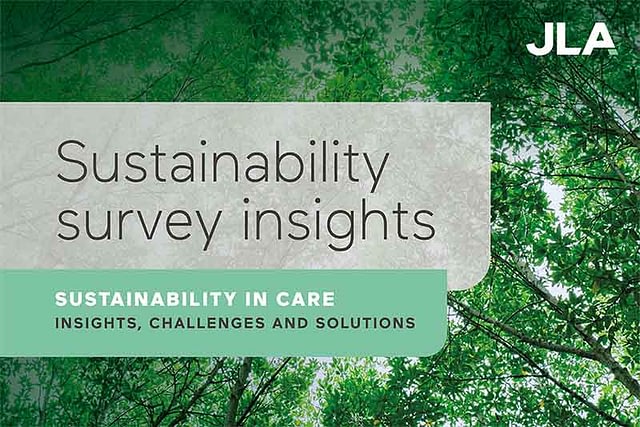Results from JLA’s survey of care professionals reveal how providers are tackling sustainability goals in their care homes – and where more support is needed.
With the CQC likely to introduce new checks on sustainability measures in the near future, JLA recently carried out a UK-wide survey of care managers and workers.
The survey captured a picture of what it’s like on the ground for homes looking to achieve change while continuing to deliver high standards of care.
Here are the key findings.

Who took part in the survey?
Survey respondents were from a mixture of care homes operating between one and ten homes to those in larger care groups with ten or more.
Almost all organisations involved (96.3%) were privately owned, with just 3.7% operated by local authorities. By care setting, 40.74% ran residential care homes, 22.22% ran nursing homes, 18.52% ran specialist care facilities, and 18.52% placed themselves in the ‘other’ category.
Sustainability is on the agenda – and cost savings are driving change
Whether in single-site homes or large care groups, sustainability is now a major priority, with well over half of JLA’s survey respondents reporting it as being central to their organisation’s overall strategy and values.
What’s more, 89% of respondents believed that operating more sustainably leads to long-term cost savings, while 85% of homes are now actively seeking sustainable products and services to integrate into their processes.
Sustainability is also recognised as important to people, too. 72% of respondents agreed that measures to reduce waste and emissions are key to attracting and retaining staff, while 81% reported that the families of their residents expect sustainable care.
What’s already happening?
Encouragingly, a majority of providers reported either working on their sustainability strategies or actively making improvements. Here are just some of the initiatives that are being put into action.
• 81% are rolling out energy efficiency measures, including LED lighting and smart controls
• 70% are engaged in waste reduction and recycling
• 63% have introduced more sustainable catering practice
• 48% are sourcing more sustainable consumables
• 44% are using water conservation measures
• 41% have invested in eco-friendly laundry practices
• 33% have engaged staff in sustainability training
• 22% are carrying out carbon footprint assessments
• 22% have secured partnerships with more sustainable suppliers
Resources pose the biggest challenge
Of those surveyed, only 32% were actively reporting on their organisations’ sustainability performance – suggesting that while the intent is strong, formal measurement and tracking processes have some way to go.
Resource challenges are more significant – over half of respondents reflected that budget constraints are the largest barrier to progress, while 52% said a lack of time and resources are slowing the pace of change in their organisations.
Meanwhile, 41% reported the effect of knowledge gaps, which make it difficult for even the most committed teams to get initiatives off the ground.
Where more support is needed
Many respondents highlighted the need for quick, practical sustainability tips, as well as starter guidance packs for use in their settings. Operators also called for more reliable suppliers who can help their sustainability plans gain momentum.
Overall, JLA’s survey has revealed the sector’s strong motivation to embrace sustainability – not just for environmental reasons, but because it’s good for staff, residents and their loved ones. With more practical tools, accessible funding and committed supply chain partners, care providers should be able to turn their ambitions into measurable impact.
For further sustainability support get your free Sustainability Toolkit here.




